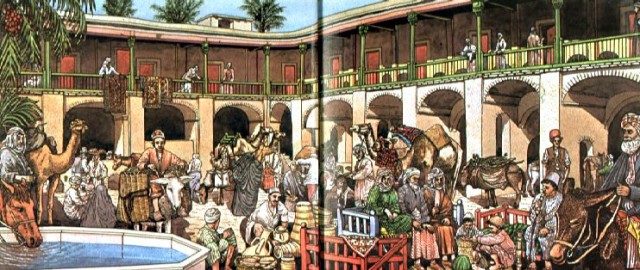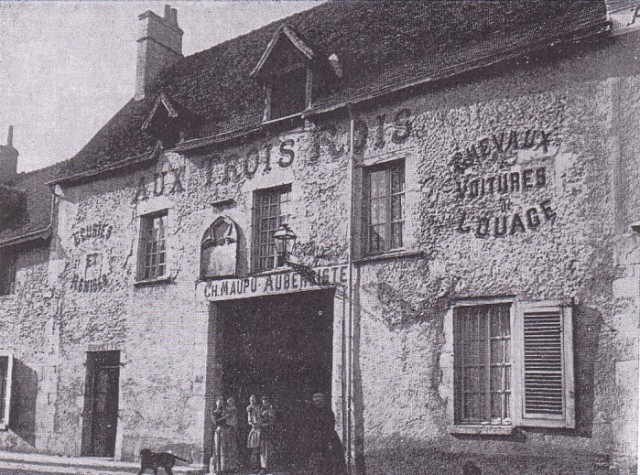A Brief History of Hotel
The history of hotel is intimately connected to that of civilizations. Or rather, it is a part of that history. Facilities offering guest hospitality have been in evidence since early biblical times. The Greeks developed thermal baths in villages designed for rest and recuperation. Later, the Romans built mansions to provide accommodation for travelers on government business. The Romans were the first to develop thermal baths in England, Switzerland and the Middle East. Later still, caravanserais appeared providing a resting place for caravans along Middle Eastern routes. In the Middle Ages, monasteries and abbeys were the first establishments to offer refuge to travelers on a regular basis. Religious orders built inns, hospices and hospitals to cater for those on the move.
Picture 1: A Middle-Age Caravanserais in the Middle East
Inns multiplied but they did not yet offer meals. Staging posts were established for governmental transports and as rest stops. They provided shelter and allowed horses to be changed more easily. Numerous refuges then sprang up for pilgrims and crusaders on their way to the Holy Land.
Travelling then became progressively more hazardous. At the same time, inns gradually appeared in most of Europe. Some of them have remained famous, for example, l’Auberge des Trois Rois in Basle, which dates from the Middle Ages. Around 1200, staging posts for travelers and stations for couriers were set up in China and Mongolia. In Europe, or more precisely in Belgium, l’Auberge Cour Saint Georges opened in Gant, while the Angel Inn was built at Grantham in Lincolnshire, England.
The Start of the Hotel Industry
In France, at the beginning of the fifteenth century, the law required that hotels keep a register. English law also introduced rules for inns at that time. At the same time, around 1500 thermal spas were developed at Carlsbad and Marienbad. During this epoch, more than 600 inns were registered in England. Their architecture often consisted of a paved interior court with access through an arched porch. The bedrooms were situated on the two sides of the courtyard, the kitchen and the public rooms at the front, and the stables and storehouses at the back. The first guide books for travelers were published in France during this period.
An embryonic hotel industry began to develop in Europe. Distinctive signs were hung outside establishments renowned for their refined cuisine. At the end of the 1600s, the first stage coaches following a regular timetable started operating in England. Half a century later, clubs similar to English gentlemen’s clubs and Masonic lodges began to appear in America.
In Paris in the time of Louis XIV, the Place Vendôme offered the first example of a multiple-use architectural complex, where the classical façades accommodated boutiques, offices, apartments and also hotels. In New York first of all, and then in Copenhagen, hotels were established in city centres. At the beginning of the 1800s, the Royal Hotel was built in London. Holiday resorts began to flourish along the French and Italian rivieras (rivers).
In Japan, Ryokan guest houses sprang up. In India, the government-run Dak bungalows provided reliable accommodation for travelers. The Tremont House in Boston was the first deluxe hotel in the city centre. It offered inside toilets, locks on the doors and an “à la carte” menu.
In 1822, in Venice, a certain Giuseppe Dal Niel transformed an old palace into a hotel and gave it his name, “Le Danieli”. As trains began to replace horse-drawn transport, highway inns for stage coaches started to decline. During this period, the Shepherds Hotel in Cairo was founded, the result of a complete transformation of an ancient city-centre harem.
L’Hôtel des Bergues was built in the spring of 1834 on the shore of the Lake of Geneva. One of its founders, Guillaume Henri Dufour, became a famous Swiss general. In 1840, l’Hôtel des Trois Couronnes was established in Vevey in Switzerland and the Baur au Lac in Zurich, fully refurbished since 1995.
Picture 2 : A 19th Century Hotel in France
The “Bayerischer Hof” was built in Munich in 1841, followed in 1852 by the “Vier Jahreszeiten”. These two famous establishments were completely renovated after the Second World War. The third boom in the hotel industry began in 1980, marked by more inventive marketing and the development of hotels increasingly adapted to a particular type of clientele.
This trend prompted the construction of hotels near airports, hotels for conferences, health hotels, ski holiday hotels, holiday villages and marina hotels. The first Property Management Systems (Fidelio, Hogatex, etc.) appear in the hospitality market.
Picture 3 : A 21st Century Hotel in Dubai
In Istanbul in 1984, work began on the renovation and transformation into a hotel of the prestigious sultans’ residence, the Ciragan Palace in Istanbul. The resulting hotel is no less prestigious than the Ciragan Palace was. Managed by the Kempinski chain, it opened its 322 rooms to guests in 1991.



